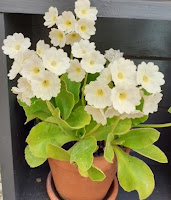 |
| Tricia |
 |
A seasonal February Garden Posy
|
This
February's meeting was an interesting presentation by
Tricia Acland
from Mungrisdale;
who had kindly stepped in at the last minute when
the original speaker became unavailable.
Illustrated
by many slides, Tricia gave a description of her own gardening
challenges due to the very windy location of her one acre garden. It
lies in a secluded valley in the shadow of Blencathra.
When
Tricia and her husband bought the property in the 1970’s, they were
keen not to make a wooded shelter belt, because they wished to
maintain the spectacular views of the surrounding fells. They did
plant some specimen trees and initially 2000 daffodils in the
grassland and beside the stream which runs across the garden.
Tricia
is keen to enjoy the naturalistic aspects of her plants, using
organic principles and the happen-stance of nature. Due to the
constant winds, plants chosen have to withstand these conditions and
although there have been some casualties, Tricia has managed to
nurture a huge variety of plants in the garden which is very stony
and acidic.
A
fairly new development has been the creation of a gravel garden, in
place of an evergreen tree which had to be removed for safety
reasons. Low lying plants (hostas, ferns, euphorbias, astrantia,
hellebores, geraniums, epimediums, eryngiums) all thrive well. In
crevices of the surrounding Lakeland stone walls, ferns and lewisia
grow happily.
There
is an alpine patch and lots of sturdy perennials like phlomis,
lilies, brunnera, meconopsis, along with a wide variety of grasses to
give height and colour throughout the year.
It
is a garden to “look out from” taking full advantage of its
stunning setting .
Written by Jude Jansen
Each
year the garden is open to the public via the NGS scheme.
“There
is really only one word to describe the view from Chapelside, and
that’s spectacular,” writes Noel Kingsbury (Gardens Illustrated,
July 2018). A little overstated? The immediate backdrop here of the
Lake District fells is always the primary consideration in design and
planting choices. Key elements are the enclosing field walls,
together with the creative use of stone more widely, often with
water. Winds are certainly harassing, but you couldn’t wish to be
snug in sheltering rooms in such a fine setting. Just look across and
through the beds and borders or over the big pond to the hills close
by!”

" In
Claire Takacs’s book Dreamscapes, a glorious photographic gallery
of gardens worldwide, much the smallest featured is Chapelside. The
listed farmhouse, fine barns and outbuildings stand comfortably in
their acre plot. “We share occupancy with house martins, frogs,
newts and red squirrels.”
This
garden is a peaceful place, respectful of its location, full of
colour, form and texture, yet within a relaxed regime allowing
self-seeding and the quirkiness of the unexpected. You will find both
familiar and less usual plants: ferns, hostas, hellebores, alpines,
anemones and meconopsis all feature. Orchids have arrived, surprising
but welcome. An informal area under the fell has mixed trees and a
meadow slope with bulbs. The approach is organic: some compost, lots
of leaf mould … perhaps more moss than grass."
Tricia has kindly provided us with a list of some of her plantings:
Trees:
Sorbus
Casmiriana Betula Jacumontii Viburnum bodnantense
Vilmorinii Malus
Golden Hornet Cytisus battandieri
Copper
Kettle Amelanchier Viburnum mariesii
Pink
Pagoda Crataegus – double & single
Autumn
Spire Oemleria cerasiformis
Shrubs:
Salix
matsudana tortosa Escallonia Physocarpus ‘Dart’s Gold’
Salix
‘Mark Postill’ Lonicera Purpusii Leycesteria ‘Golden Lanterns’
Stephandra
tanakae Philadelphus S. incisa ‘Crispa’
Leucothoe Rose
de Rescht R. Ispahan
R.
‘Seagull’ R.‘Dunwich Rose’ R. cantabrigiensis
Climbers:
Clematis
‘Morning Yellow’ C. wilsonii Hydrangea petiolaris
C.
alba luxurians caerilea
Perennials
(just a few):
Inula
hookeri Mathiasella ‘Green Dream Gillenia
Lysimacia Thermopsis Camassias
white (semi plena) & blue
G.
Mrs Kendall Clark G.Rozanne G.conereum ‘Purple Pillow’
Omphalodes
‘Starry Eyes’ Astrantia ‘Roma’ Iris – sibirica /
chrysographes
Eryngium
Amethyst Blue E.agavilium E.horridum
Paris
polyphylla Phlomis russeliana Seseli libanotis Acaena
Grasses:
Calamagrostis
‘ Karl Foerster’ Miscanthus ‘Gracillimus’ Carex
testacea Panicum v.’Squaw’
And finally a super seasonal summary from Joe Swift's February Saturday Times article about pruning:
 |
| RHS Image - Pruning cut - remember your gloves! |



























